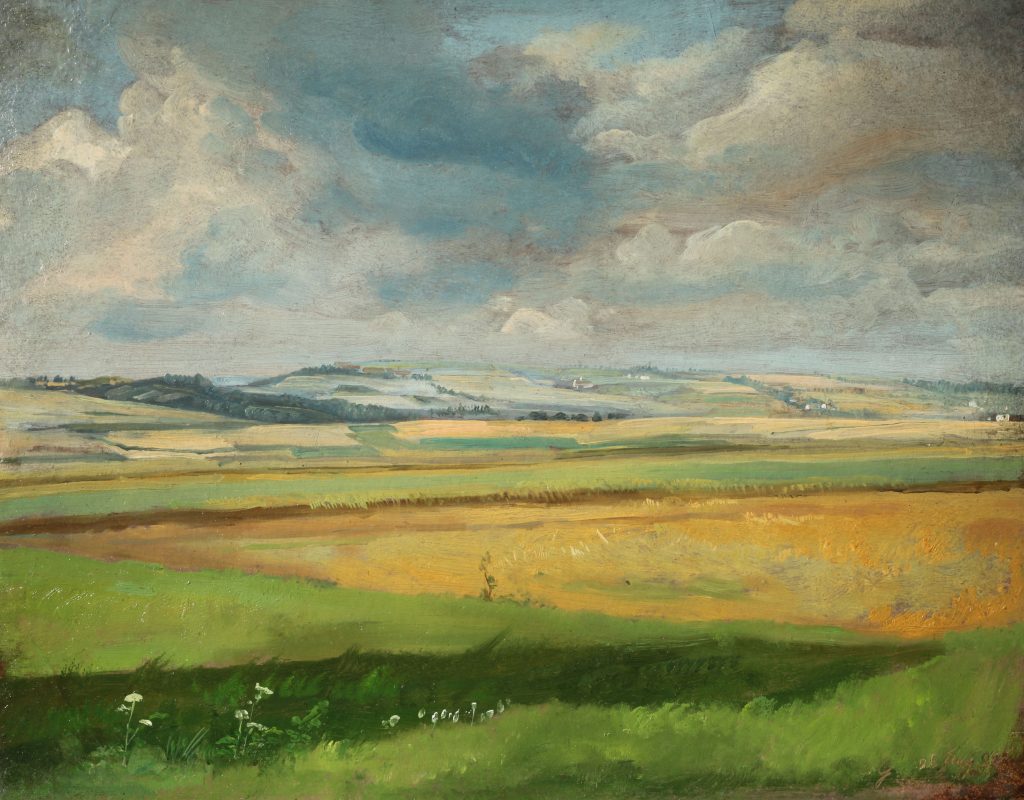Christian Friedrich Gille
(Ballenstedt 1805 - 1899 Dresden)
View of the Elbe Valley near Dresden, 1831
Oil on paper, laid down on cardboard, 23.3 x 29.5 cm
Signed with the initials and dated lower right CG 26 Aug 31 (incised in wet paint)
Provenance:
Estate of the artist;
acquired from aforementioned by Friedrich Asch, Dresden (see label on the verso dated November 26, 1920);
Private collection, Germany.
Literature:
Gerd Spitzer, Christian Friedrich Gille 1805-1899: Malerische Entdeckung der Natur, Petersberg 2018, p. 91, fig. 1
Christian Friedrich Gille is without doubt the most important of all Johan Christian Dahl’s pupils. He was a dedicated exponent of plein-air painting and shared Dahl’s belief in its advantages, putting into practice the advice of Carl Gustav Carus as expressed in the eighth letter of his treatise, Nine Letters on Landscape Painting: ‘The artist must therefore learn to speak the language of nature; and the place of such instruction can only be the natural landscape itself ...’[1]
Gille did not play a prominent role in Dresden’s artistic circles as a young man and this was not to change significantly during his long life. He earned his living as a printer and lithographer and had only limited contact with other artists. Somewhat unusually for an artist of the period, he never travelled beyond the environs of Dresden, nor did he explore other parts of Germany or visit Italy. His plein-air oil sketches received scant recognition during his lifetime but it is precisely they that have grown to be highly prized by present-day collectors and art historians. As Hans Joachim Neidhardt, one-time curator at Dresden’s Gemäldegalerie Neue Meister, noted: ‘What makes these landscape studies so important from an art-historical viewpoint is the new aesthetic approach that inspired them. It springs from a desire to capture in rapid brushstrokes the fleeting experience of a visual impression.’[2] Unlike his teacher Dahl, Gille left a large body of oil sketches and drawings and only very few finished paintings. This, too, might explain why his œuvre was overlooked for so long.
Gille’s plein-air studies for the most part depict landscapes in the vicinity of Dresden and often focus on small, unspectacular elements of closely observed natural detail. He would explore the surrounding countryside on foot seeking out scenic subjects – such as the present landscape motif. Gerd Spitzer, former chief curator at the Galerie Neue Meister in Dresden and a leading expert on Gille’s work, discusses the present study in a recent publication on the artist. In his opinion the study depicts a view from the slopes of the Elbe valley north-east of Dresden. Gille has scratched the precise date of execution, 26 Aug 31, into still-wet paint with the end of the brush. In the lower half of the composition the use of horizontal bands of color creates an illusion of space and depth. The juxtaposition of sky and landscape is carefully balanced. Grey and white clouds mingle with areas of blue sky and form a cool counterpoint to the colorful interplay of golden cornfields and green meadows beneath. Gille uses rapid, mobile brushwork to capture the brightness of a sun-saturated landscape but at the same time carefully observes the effects of prevailing light and weather conditions.
- Published in the years 1815 to 1824. See Marianne Prause, Carl Gustav Carus, Leben und Werk, Berlin 1968, p. 45 and note 162.
- Hans Joachim Neidhardt, Die Malerei der Romantik in Dresden, Leipzig 1976, p. 191 f.

